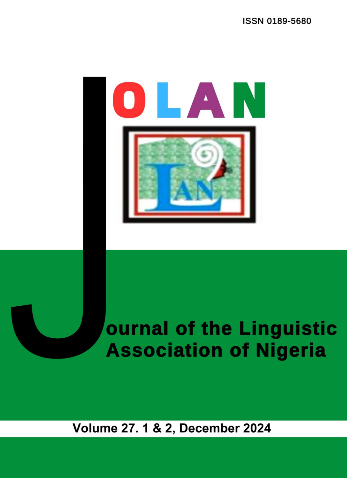Cohesion in Native Poetry: An Analysis of English-Translated Tiv-Gbangi Oral Verses
Keywords:
Cohesion, Oral verse, Poetry, Tiv-Gbangi verse, TranslationAbstract
This paper seeks to establish the use of cohesive linkages in the Tiv oral verse. Some Gbangi songs by Pevikyaa Zegi, one of Tiv’s most famous living poets, artists and singersare purposively selected for analysis. Like the oral verse of most peoples of Africa, Tiv poetry is incorporated into the tribe’s way of life and deals with its day to day issues and problems of life (Jenkwe, 1998:1). The actual basis for meaning making in Tiv oral verse which also culminates into style is clearly demonstrated by the beauty with which language is used and the success attained in the experiment of using words, followed by the compatibility of language elements in exciting contexts. What qualifies Tiv poetry and gives it, its overall meaning and success is its independence on style. Cohesion of elements of language with the accompaniment of other figurative usages defines style in the Tiv oral verse. The study therefore, evaluates the lexical and grammatical devices which indicate connection between different units of the extracted texts translated for investigation. In doing this, the study adopts Halliday and Hasan’s (1976) theory of cohesion to support the analysis of the functions of connection in the texts. Halliday and Hasan contend that the main thing that determines whether a set of sentences or a piece of language do or do not constitute a text depends on the relationships which exist within and between the sentences which make up the text. They therefore, identify types of cohesion as reference, lexical, conjunction, substitution, and ellipsis. Our investigation reveals that different kinds of cohesion exist in the Tiv oral verse and are contributive of the exciting style achieved by the Tiv Poet. The study concludes that without the expanded systemicfunctions undertaken by cohesive usages in the text, what Halliday and Hasan call texture would not have been felt and the verses would have lacked solidity, organization, interconnection and interrelationship of language elements. With cohesion in the texts, a listener receives a system of information as indestructible continuum.
References
Dada, P. O (2004) English and Literary Stylistics. Makurdi: Abogom Press
Crystal, D. (2001) Language of the Internet. Cambridge: Cambridge University Press
Fakuade, A.G. (1998) The Place of Register and Text in Stylistics. In Studies in Stylistic and Discourse Analysis. Fakuade (ed). Yola: Paraclete Pub.
Gbilekaa, S. (2013) Another Voice: Meta-Critical Essays in Drama, Theatre and Politics. Zaria: ABU Press Ltd
Halliday, M.A.K. and Hasan, R. (1976) Cohesion in English. Singapore: Longman
Hoey, M. (1991) Patterns of Lexis in Text. Oxford: Oxford University Press.
Jenkwe, T.E. (1998) Yanmoel Yashi: A Study of Tiv Oral Poetry. Aba: AAU Vitalis Books Company.
Koch, K (1998) The Language of Poetry. Retrieved online, 1 Pm, 14th November 2016.
Mbunda, F.M. (2007) Folklore and National Identity: A Lesson for Nigeria. InLanguage and Literature in a Developing Country: Essays in Honor of Professor Benson O.A. Oluikpe. Anasiudu B.N. etal (eds). Onitsha: Africana- First Pub. Ltd
Orjime, D.S. (2004) Syntax and the Study of Tiv Language. Makurdi: Selfers Publications.
Riddell, R. (2010)The Language of Poetry. Retrieved online, 1.30Pm, 14th November on New York Review of http://www.ronriddell.com/Books
Robbins, D (1997) The Language of Poetry. Retrieved online, 1 Pm, 14th November on artsreformation.com
Syal, O and Jindal, D.V. (2008) Language, Grammar and Semantics. New Delhi: Prentice-Hall India.
Ukoyen, J. (1997) The Translation of Literary Book Titles in English and French: A Stylistico-Semiotic Study. Ibadan Journal of Humanistic Studies. Number 7. Ibadan: UI Press














